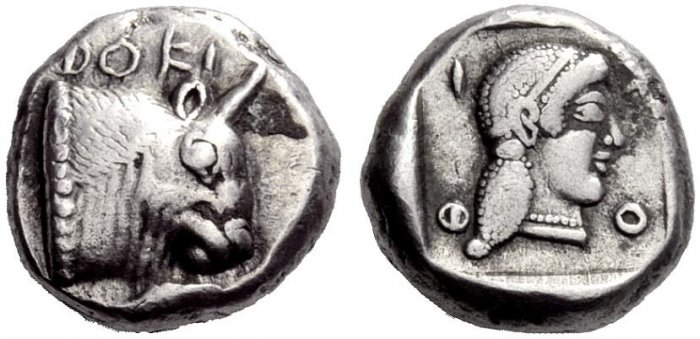S 1918 - Phocis (various mints) (Phocian League), silver, triobols (510-460)
From SILVER
510 BCE - 460 BCE Silver 1,333 kg
Description
| ObverseInscription or printing placed on the obverse.: | ΦOKI (Greek).Profile head and neck of bull to r. with beaded truncation at the shoulder. Below, seal r. |
| ReverseInscription or printing placed on the reverse.: | ΦOKI (the K reversed) in the four corners starting from bottom l., anticlockwise (Greek).Small head of Artemis r., in incuse square |
Mint and issuing power
| MintIdentifies the place of manufacture or issue of a numismatic object.: | Phocis (various mints) | Ancient regionAncient region.: | Phocis | Modern countryModern country: Greece | AuthorityIdentifies the issuing power. The authority can be "pretended" when the name or the portrait of X is on the coin but he/she was not the issuing power. It can also be "uncertain" when there is no mention of X on the coin but he/she was the issuing power according to the historical sources: | Phocian League |
Chronology
| FromIdentifies the initial date in a range assigned in a numismatic context. | 510 BCE | toIdentifies the final date in a range assigned in a numismatic context.. | 460 BCE | PeriodTime period of the numismatic object.: Archaic and Classical |
Physical description
| MetalThe physical material (usually metal) from which an object is made.: | Silver |
Median weightMedian of the weights of numismatic objects (in grams). in grams | 3.00 | DenominationTerm indicating the value of a numismatic object. Examples: tetradrachm, chalkous, denarius.: | hemidrachm |
StandardStandard.: |
Image

S1918 Phocis triobols Gr. I-II.jpg [1]
References
| Die study referencePublication of the study: | Williams 19721Williams 1972, p. 71-96 (Periods I-II) | ||
| Coin series referenceReference to coin series study: | Sear I2Sear I, n° 2346-2347 | ||
Obverse dies distribution
| FrequencyFrequency of specimen in distribution. ᵖ | Number of obversesNumber of obverse dies. ᵖ (o) | % (o) | Number of coinsNumber of coins. (n) | % (n) | Die nameName(s) of the die(s). |
| 1 | 7 | 36.84 | 7 | 9.33 | 1, 2, 3, 5, 13, 14, 15 |
| 2 | 2 | 10.53 | 4 | 5.33 | 16, 48 |
| 3 | 1 | 5.26 | 3 | 4 | 20 |
| 4 | 2 | 10.53 | 8 | 10.67 | 19, 55 |
| 5 | 2 | 10.53 | 10 | 13.33 | 4, 49 |
| 6 | 1 | 5.26 | 6 | 8 | 18 |
| 7 | 1 | 5.26 | 7 | 9.33 | 12 |
| 8 | 2 | 10.53 | 16 | 21.33 | 11, 47 |
| 14 | 1 | 5.26 | 14 | 18.67 | 17 |
| Total | 19 of 19 | 100 | 75 of 75 | 99.99 |
Reverse dies distribution
no distribution is available
Quantification
| Number of obversesNumber of obverse dies. ᵖ (o) | 19 | Number of singletons (o1)The number of singleton coins. ᵖ | 7 |
| Number of reverse diesNumber of reverse dies. (r) | Number of coinsNumber of coins. (n) | 75 | |
| Coins per obverse dieNumber of coins per obverse die. (n/o) | 3.95 | Coins per reverse dieNumber of coins per reverse die. (n/r) | |
| Reverse per obverse ratioRatio of obverse dies divided by reverse dies. (r/o) | Percentage of singletons (o1)number of coins (n) divided by the number of singletons (o1) ᵖ | 36.84 % | |
| Original number of dies (O) (Carter 1983 formula)The estimation of the number of coins according to Carter 1983 ᵖ | 22.21 | Coins struck if 20,000 as average productivity per dieCoins made if the average productivity for obverses (according to Carter) is 20,000. ᵖ | 444,200 |
| Original number of dies (O) (Esty 2011 formula)The estimation of the number of coins according to the singleton formula in Esty 2011 ᵖ (O) | 25.45 | Survival rate if 20,000 as average productivity per dieSurvival rate if average productivity is 20,000. ᵖ | 0.00017 |
| Coverage (o = % of O) (Esty 1984 formula)Esty 1984 - coverage (% of O) ᵖ (o = % of O) | 90.67% | Die productivity if survival rate 1/2,000Average productivity if survival rate is 1/2,000. ᵖ | 6,753.71 |
| Weight of silver (in kg) if 20,000 coins per die (O = Carter formula)Carter 1983 * Median weight * 20000 (*10 if gold or electrum) ᵖ | 1,333 kg <br /> 1,333 kg | Die productivity if survival rate 1/5,000Average productivity if survival rate is 1/5,000. ᵖ | 16,884.29 |
Remarks